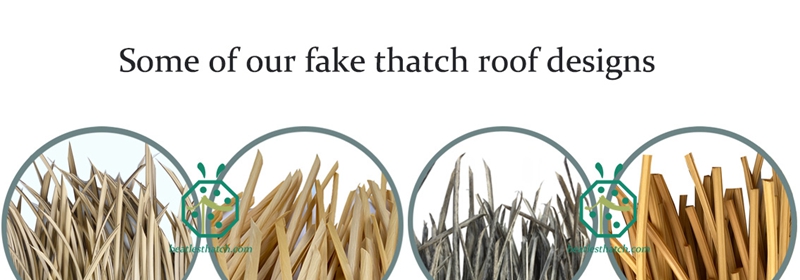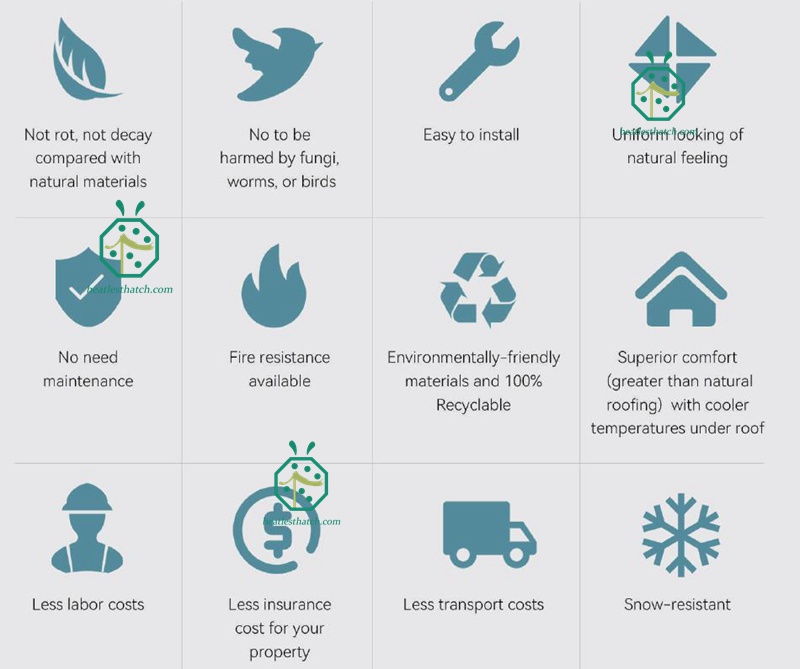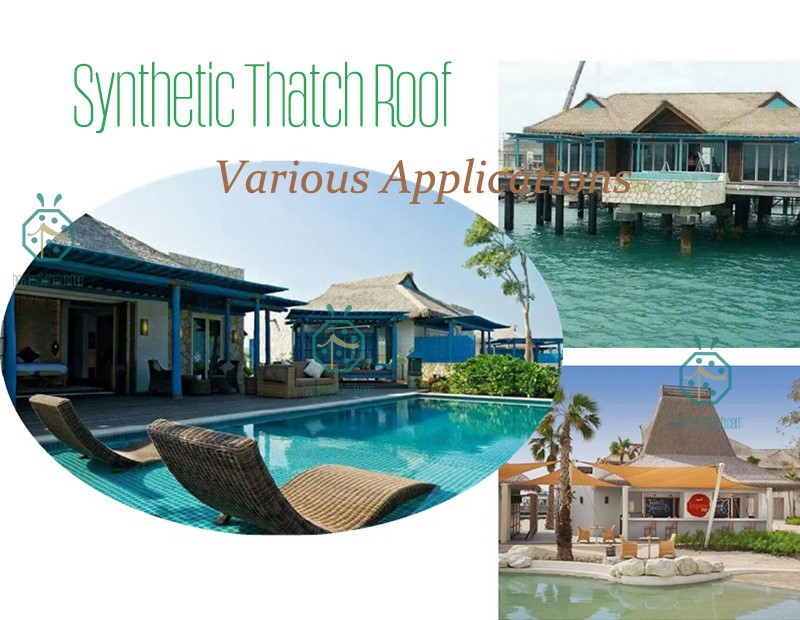Synthetic thatch roof is an alternative product of natural thatch roof materials. It is also called artificial thatch products, fake thatch, faux thatch, imitation thatch, resin thatch, or fiber thatch. Synthetic thatch has become a popular alternative to traditional thatch roofing, especially for those who desire the look of natural thatch but with less maintenance and longevity. Let us introduce the synthetic thatch roofing products detailly in this article:
1. Materials of synthetic thatch roof:
Synthetic thatch roof is made from various synthetic materials such as HDPE, LLDPE, PVC, PP, nylon and other resins, synthetic thatch has an advantage over natural thatch in that it is virtually maintenance-free and long-lasting. It is also more resistant to fire, insects, and weather conditions than natural thatch. Among the materials, HDPE and LLDPE are the most durable materials if the correct formula of additives of UV retardant and antioxidant are added for production together. For the high humidity area, nylon thatch is a good option too. New materials are required for high quality artificial thatch roof products. Compared with new materials, recycled materials artificial thatch will have decay issue so easily in a year or even some months.
▧ Good materials for high quality synthetic thatch:

▧ Bad materials for poor quality synthetic thatch roof:

2. How many types of synthetic thatch roof tiles?
We could customize colors, textures, sizes, etc. of the synthetic thatch roof tiles to simulate the natural thatch roof materials. Below are some of the common types of synthetic thatch roof tiles that are simulated to natural thatch products:
▧ Bali grass thatch
▧ African reed thatch
▧ Water reed thatch
▧ Wheat straw thatch
▧ Cape reed thatch
▧ Norfolk reed thatch
▧ Alang-alang thatch
▧ Bamboo thatch
▧ Palm leaf thatch
▧ Raffia palm thatch
▧ Nipa palm thatch
▧ Pandanus thatch
▧ Sago palm thatch
▧ Thatch grass
▧ Elephant grass thatch
▧ Cogon grass thatch
▧ Kikuyu grass thatch
▧ Vetiver grass thatch
▧ Papyrus thatch
▧ Rush thatch
You could contact us for our catalog and product list to check more carefully for our synthetic thatch products.
Below are some photos of our synthetic thatch products:

3. Benefits by using synthetic thatch roof products:
Synthetic thatch offers a sustainable, durable, and cost-effective alternative to natural thatch. With the added benefits of versatility, low maintenance, and eco-friendliness, synthetic thatch is a great choice for those seeking a beautiful and long-lasting roofing solution.
▧ Durability:
When properly installed and maintained, it can last up to 20 years, even in harsh weather conditions. Natural thatch, on the other hand, can only last up to 3-6 years, and requires regular maintenance to prevent mold and insect infestation.
▧ Eco-friendly:Synthetic thatch is eco-friendly because it is made from renewable resources that are non-toxic and recyclable. Traditional thatch roofs require constant re-thatching, which can result in cutting down more trees to produce new thatch, and the discarded old thatch takes up valuable landfill space. Synthetic thatch, on the other hand, can be recycled again at the end of its lifespan (However, not suggest to use recycled materials for production of synthetic thatch roof products).
▧ Versatility:
Synthetic thatch also offers a wide variety of styles and colors to choose from, making it a versatile roofing option for different types of houses and buildings. One can choose from different thatch styles such as African Cape Reed, Tahitian Palm, and Fijian Thatch to suit one's design preferences.
▧ Minimal maintenance:
Unlike natural thatch, synthetic thatch doesn't get moldy, rot, or attract insects. It can easily be cleaned with a pressure washer to freshen up its appearance.
▧ Affordability:
Synthetic thatch may cost more upfront than natural thatch, but in the long run, it is a more cost-effective option. It requires less maintenance, replacement, and repairs than natural thatch, reducing the overall cost of ownership.

4. What type of bottom roof structures could install synthetic thatch roof?
Nearly no special limit for the installation of faux thatch roof tiles, unless no sub-roof on the bottom. For below sub-roof structures, faux thatch roofing materials are no problem for installation:
▧ Timber-framed roofs
▧ Wattle and daub roofs
▧ Bamboo-framed roofs
▧ Steel-framed roofs
▧ Concrete roofs
▧ Plywood roofs
▧ Straw bale roofs
▧ Reclaimed wood roofs
▧ Cob roofs
▧ Rammed earth roofs.
5. What buildings to use synthetic thatch roofing?
There are various buildings in the world to install artificial thatch roof products for decoration and create their own tropical ambient. Below building structures are using artificial thatch always:
▧ Farmhouses
▧ Cabins
▧ Beach houses
▧ Gazebos
▧ Restaurants
▧ Hotels
▧ Museums or historic sites
▧ Theme parks or attractions
▧ Churches or religious buildings
▧ Outdoor classrooms or event spaces.
▧ Barns
▧ Stables
▧ Storage sheds
▧ Playhouses
▧ Treehouses
▧ Traditional roundhouses or yurts
▧ Villas or lodges
▧ Tourist accommodations (e.g. safari tents, eco-lodges)
▧ Cultural centers or community buildings
▧ Pubs or breweries.
▧ Cabins or cottages
▧ Gazebos
▧ Garden pavilions
▧ Pergolas or trellises
▧ Outdoor kitchens or dining areas
▧ Boat houses or docks
▧ Studios or workshops
▧ Meditation or yoga spaces
▧ Guest houses or B&Bs
▧ Glamping tents
▧ Rustic restaurants or cafes
▧ Wedding or event venues
▧ Archaeological sites or museums
▧ Churches or chapels
▧ Forts or castles
▧ Historical reenactment buildings
▧ Amphitheaters or open-air theaters
▧ Community gardens or orchards
▧ Sports facilities or recreational centers
▧ Beach huts or surf shacks.
